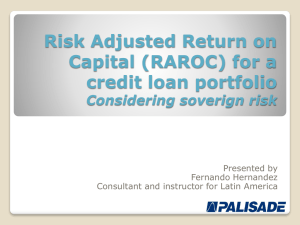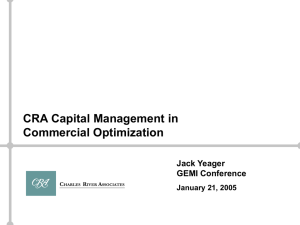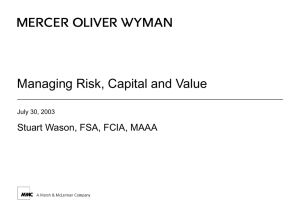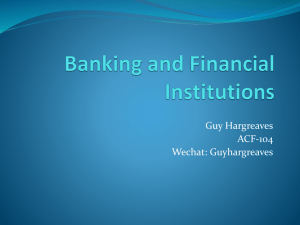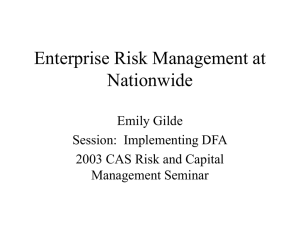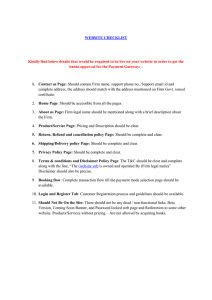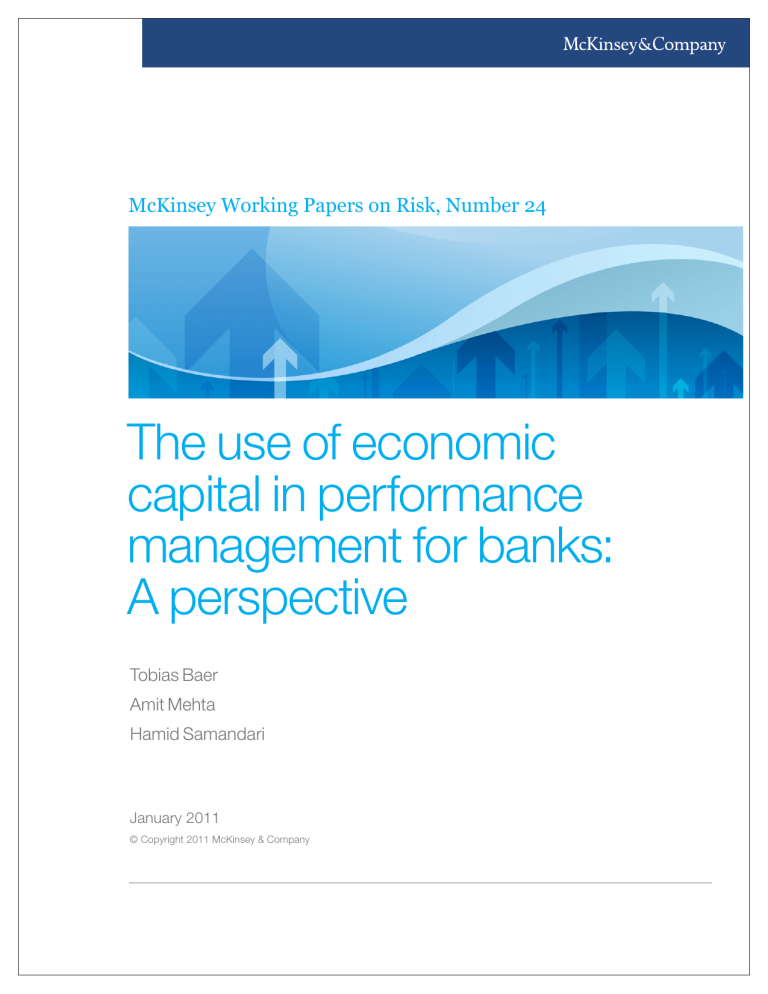
McKinsey Working Papers on Risk, Number 24 The use of economic capital in performance management for banks: A perspective Tobias Baer Amit Mehta Hamid Samandari January 2011 © Copyright 2011 McKinsey & Company This report is solely for the use of client personnel. No part of it may be circulated, quoted, or reproduced for distribution outside the client organization without prior written approval from McKinsey & Company, Inc. Contents Introduction 1 Why is economic capital important? 2 Granularity of economic-capital allocation 4 Linking economic capital to performance management 6 Setting RAROC targets and hurdle rates 9 Looking to the future 13 McKinsey Working Papers on Risk presents McKinsey’s best current thinking on risk and risk management. The papers represent a broad range of views, both sector-specific and cross-cutting, and are intended to encourage discussion internally and externally. Working papers may be republished through other internal or external channels. Please address correspondence to the managing editor, Rob McNish (rob_mcnish@mckinsey.com) 1 The use of economic capital in performance management for banks: A perspective EXECUTIVE SUMMARY Amid heightened concern about the future of regulatory-capital requirements, economic-capital modeling and its application are enjoying a renaissance in the post-crisis banking world. This trend is driven by three factors: (i) The crisis has fostered a renewed appreciation by both banks and regulators of the need for standard economic-risk measures informed by internal data (ii) Institutions perceive a heightened need for performance-tracking and pricing tools that incorporate an economic cost of risk. (iii) Changes in the culture of financial institutions, as well as new developments in data architecture and modeling, are removing practical obstacles that hindered earlier efforts. Our discussions with 11 banks around the world provide ample evidence of this resurgence. These discussions also revealed that the typical bank uses risk-adjusted return on capital (RAROC) in a backward-looking manner and at the aggregate, not the transaction, level. This suggests that the adoption of return hurdles that capture the contribution of each business to the cost of capital, as well as the capital requirement, of an institution would constitute a major improvement in capital allocation, business-performance tracking, and risk management. I. INTRODUCTION In the wake of the global credit crisis, capital has become a scarce resource. Still reeling from the effect of important and unanticipated losses, a large number of banks are now struggling to conserve and manage capital. The impact on the banking system has been significant and immediate: many institutions have had no other choice but to reallocate or even reduce their portfolios. Capital management is first and foremost driven by risk. Indeed, because risk can trigger losses that deplete their capital, banks must carefully consider the potential unexpected losses that are associated with each individual activity. Value maximization requires financing only businesses that are sufficiently profitable after their capital consumption is taken into account. It is therefore crucial that performance measurement adequately reflects this consumption. In order to understand the current state of practice in the evaluation of risk-adjusted performance in the banking system, we recently surveyed a diverse group of 11 leading banks in North America, Europe, and the AsiaPacific region. The purpose of this paper is to present the survey’s results. These results show growing interest in risk-capital models. However, these models are at present mostly restricted to the evaluation of business units and other top-management decisions; they are not used to drive day-to-day business decisions. In particular, they are rarely explicitly used in the pricing or approval of individual transactions. Financial institutions have not yet fully taken advantage of the benefits of these techniques, and there is substantial room for improvement in the optimal allocation of constrained capital resources. 2 The paper proceeds as follows. The next section presents the motivations behind risk-capital modeling and explains its scope. Section III examines the granularity of capital allocation. Section IV discusses applications to transaction evaluation, pricing, and approval decisions. Section V considers the hurdle rates used in evaluating returns, and Section VI presents our conclusions. II. WHY IS ECONOMIC CAPITAL IMPORTANT? Two important metrics constitute the foundation of risk-capital models: RAROC and economic value added (EVA). RAROC expresses expected profit as a percentage of economic capital. The formulation of these two input variables is quite specific. The first variable, expected profit, takes expected loss into account. The second variable, economic capital, reflects the risk appetite of the institution or, in other words, the probability of failure that it is willing to accept. More specifically, economic capital is the bank’s best estimate of the capital required to absorb losses up to a chosen probability of failure.1 The mathematical expression for RAROC can be written as follows: RAROC = Expected profit Economic capital = Return – expected loss – expenses Economic capital EVA is a related concept. The difference between the two metrics is that RAROC, like any return, is a relative measure of the profitability of capital and is particularly useful to compare alternative investments or to determine whether a target rate has been met. EVA, on the other hand, is an absolute measure that provides the actual amount of profit an institution earns beyond the cost of its equity. Indeed, the “excess return” measured by RAROC above the cost of capital is EVA. Of the two metrics, RAROC appears to be the most widely used by Return – expected – expensescomplement or alternative to RAROC. survey respondents; however, EVA loss is a necessary ≥ Cost of capital Economic capital RAROC and EVA are not new. As early as the 1970s, pioneers such as Bankers Trust were using RAROC. By the 1990s, a fair number of banks were pursuing internal risk-capital models; however, most of these efforts were unsuccessful because companies lacked data, made use of an imperfect methodology, or faced other business pressures. Although the challenges of implementation should clearly not be underestimated, when properly set up, Returnmanagement – expected loss – expenses these tools empower to maximize the bank’s returncost on capital (subject to business and other ≥ Marginal of capital Marginal economic capital constraints). Indeed, recent experience, for instance, in the area of mortgage loan pricing, suggests that some RAROC models may have been prematurely abandoned or their results ignored. An incomplete and rudimentary implementation is often the underlying cause of these issues. The survey reveals that the vast majority of respondents use economic-capital models. However, they use them to varying degrees, as illustrated in Exhibit 1, with approximately half the respondents having an economiccapital model for the full bank.2 This indicates that the notion of economic capital is gaining acceptance in the banking industry. This is a significant development because, after an initial wave of implementation in the 1990s, economic capital fell out of favor. In addition to the requirements imposed by the Basel II framework (the Internal Capital Adequacy Assessment Process of Pillar II), this resurgence is due to recent successes in addressing several issues that thwarted earlier efforts. In particular, four main problems needed to be solved. 1 2 Readers interested in the details of calculating economic capital may refer to McKinsey’s Working Paper on Risk No. 11, “Best practices for estimating economic capital,” available at http://www.mckinsey.com/clientservice/risk/ risk_working_papers.asp Quantitative results from a survey of 11 respondents are not statistically representative, and as such, the detailed numbers are not shown. However, the height of the bars indicates the relative strength of each practice as uncovered by our discussions. 3 The use of economic capital in performance management for banks: A perspective Exhibit 1 Banks use models of economic capital to varying degrees. Responses from survey respondents Bank-wide economiccapital model Partial bank coverage “We have a global economiccapital framework that influences capital allocated to business units” “An economic-capital model is used for products where regulatory capital is inadequate (such as structured products)” Consensus of sample supports the use of economic-capital modeling, although the breadth of coverage varies “Economic capital is limited for our new acquisitions because of data-compatibility problems” “We do not yet have an economic-capital model, but some proponents are pushing it” No economiccapital model “‘Common sense’ controls are in place; our skill is in ensuring that quantitative methods pass a business ‘sniff test’” First, the cultural gap between the “quants” who promote risk models and the skeptical business managers who use these models had to be bridged. Successful implementation requires that all levels of the organization support and accept these methods as an essential part of the bank’s modus operandi. Second, the different data architectures for risk and return had to be reconciled. The resulting improvements in data consistency have allowed the development of more accurate, reliable, and informative models. Third, sufficient data on the “tails” of loss distributions needed to be collected. Such data are generated by rare “stress” events and have now become much more available thanks to the recent crisis. In particular, these data provide better estimates of correlations between losses across different risk categories. This enables models to better predict how, for example, market-risk losses could coincide with credit- or operational-risk events. Fourth, misleading shortcuts, such as the use of regulatory-capital requirements instead of a much more risksensitive variable, had to be rejected. It is also worth noting that banks now recognize the need for discipline in assigning capital charges during expansions as well as contractions of the credit cycle. RAROC’s power comes from a few key characteristics. Banks can use RAROC to identify deals that may appear to generate great profit but have more than a commensurate capital requirement. This feature is crucial not only because it exposes seemingly profitable but excessively risky businesses, but also because it draws attention to businesses that offer high risk-adjusted returns despite perhaps deceptively low gross returns. Another useful quality of RAROC is that it is forward-looking. This discourages short-term optimization of sales volume at the expense of large losses in the future. Finally, RAROC is exhaustive and flexible: all financial variables, such as revenue, cost, and capital, are taken into account and can be aggregated up to the businessunit or company level or refined to the level of individual branches, customers, or deals. This flexibility is only limited by the availability of data. 4 As mentioned above, about half of the respondents have implemented a bank-wide economic-capital model. Of the remaining banks, some face technical constraints to roll out economic capital into all their divisions; others calculate economic capital explicitly only for the most critical cases. For instance, in corporate lending, it is necessary to carefully evaluate each transaction because of the thin margins. Therefore, our observations suggest that the current state of practice is widespread but rather incomplete use of economic capital in bank decision making. The primary role of economic capital is to track business-unit performance and ensure safety for bondholders. This approach reduces economic capital to its canonical function: providing a cushion to absorb losses. Within this context, a few sampled banks emphasize the use of economic capital as a better risk metric than regulatory-capital requirements. However, more sophisticated applications, such as pricing commercial transactions, using risk-based strategic decision making, and conducting risk-based allocation of regulatory capital, as well as determining the optimal size of subportfolios, appear less prevalent in our sample. Exhibit 2 gives an overview of survey responses. Exhibit 2 Institutions have incorporated economic capital in decision making. Responses from survey respondents who hold economic capital, multiple answers per respondent Tracking performance of individual business units or portfolios via return on economic capital “Economic capital is computed ex post and used for portfolio review but not for decision making” Achieving safety for bondholders/bank as a whole “Economic capital is important because regulatory capital underestimates many of our risks” Pricing commercial transactions “Economic capital is used for products where regulatory capital is deficient (for example, for structured products)” Informing strategic/ business decisions Using as weight to break down/allocate regulatory capital for business units (technical matter) “We hold regulatory capital, but we use a stochastic economic-capital model to allocate it” Setting risk-sensitive limits to the size of individual portfolios by means of allocated capital “An important function of economic capital is to limit the size of portfolios that exceed an economic-capital leverage limit” Uses of economic capital vary within the sample: ▪ Frequently used to track business-unit performance and for safety ▪ Occasionally used to price commercial deals, inform strategy, and allocate regulatory capital III. GRANULARITY OF ECONOMIC-CAPITAL ALLOCATION In principle, a financial institution could allocate economic capital to every transaction; however, in practice, the granularity of allocation is limited by the precision of risk measurement. The quantification of risk must be consistent across the institution, its technical infrastructure, and its operational constraints. For instance, it may not be practical for the front line to communicate credit-card pricing on a case-by-case basis. Our observations suggest that economic capital is often allocated at the business-unit level; more detailed applications are made selectively. For example, economic capital is allocated by desk in capital markets and 5 The use of economic capital in performance management for banks: A perspective by business in private banking. A minority of institutions allocate capital by individual transaction for particular transaction types, especially large commercial loans. When evaluating client relationships, a number of institutions allocate economic capital by counterparty, and only a few players aggregate these results to the country level. Exhibit 3 summarizes these findings. Exhibit 3 Economic capital can be allocated at a number of levels. Responses from survey respondents who hold economic capital, multiple answers per respondent By business unit or subportfolio Business unit is the most common product dimension … By desk or business By product … but some institutions allocate at a more granular level By transaction, for selected transactions By counterparty By geography/ country Counterparty is the most common client dimension … Consensus view of sampled banks supports businessunit or subportfolio allocation; a few allocate by geography, counterparty, product, or transaction … and some institutions aggregate to geographies In our view, the best practice is to allocate economic capital at the margin to distinct contributors of risk (such as product line or client relationship) and at a level of detail that is consistent with the precision of the measure. This allows the best possible pricing of risk and minimizes internal arbitrage opportunities that arise when riskier transactions are underpriced because they are bundled with safer ones. In order to achieve this level of detail, the best models compute economic capital from the bottom up, incorporate every significant transaction, and explicitly allocate diversification benefits. Although measurement noise may be high for individual transactions, it should average out when aggregated to a business unit or a client segment. However, when economic capital is allocated from the top down, the bank may experience a vicious circle in which the portfolio grows more and more in the very areas where risk is underestimated. This could leave the institution critically exposed to a particular risk scenario. Only a rigorous stress test would be able to detect such a scenario and trigger corrective actions through other levers such as portfolio limits. At the product level, the industry will benefit from wider adoption of the practice of allocating economic capital to all desks and businesses but only to selected transactions, especially the larger ones in commercial lending and capital markets. Although it is difficult to price transactions correctly without such a detailed analysis of capital costs, only a minority of our survey respondents currently go this deep. 6 Banks will also find it useful to sort and track capital consumption by specific embedded market risks, such as the sensitivity to oil price or to exchange rates for the US dollar and Japanese yen. When borrowers are sensitive to market risks, it is increasingly important for institutions to integrate these risks with similar ones elsewhere in the organization (for instance, in flow trading). Exhibit 4 presents the different levels of granularity. Exhibit 4 Banks can also allocate economic capital based on embedded market risk. Subportfolio Product cut Business unit Bank Most common Minority Not observed Transaction (at least selectively) Embedded market risk (foreign exchange, commodity price) Geography Obligor Segment Client-segment cut Additional insights can be gained by aggregating and identifying some risk concentrations: first, by sector (for example, automobiles, shoes, or commercial-real-estate developers) or client segment (for instance, subprime customers), and second, by region, especially for countries with unique regulatory environments (such as China, India, and Argentina). As noted earlier, the possibility of developing correlation matrices across asset classes is a powerful feature of the economic-capital framework. These matrices allow companies to better estimate the marginal contribution of each type of risk to the overall risk profile. While this was not a core survey issue, a few institutions noted that the lack of a robust correlation matrix prevented bank-wide aggregation of the economic-capital model. IV. LINKING ECONOMIC CAPITAL TO PERFORMANCE MANAGEMENT RAROC reflects the economic view of the marginal risks.3 It can be used ex post, to measure the risk-adjusted profitability of a business unit or segment. It can also be used ex ante, to set prices or make significant transaction decisions based on a minimum acceptable RAROC. The discussion has thus far focused on the challenges in estimating and allocating economic capital, the denominator in RAROC’s formula; proper application of RAROC also requires care in estimating the numerator, 3 In the literature, semantic variants on RAROC have included RORAC (return on risk-adjusted capital) and RARORAC (risk-adjusted return on risk-adjusted capital); these are more or less equivalent. The use of economic capital in performance management for banks: A perspective expected profit. For instance, during the credit bubble, returns were overestimated because current average losses were used in place of lifetime expected losses when computing expected profit. Average losses are usually low during periods of high growth in origination because new loans do not generate much loss. This experience illustrates how important it is to calibrate risk models that are based on expected loss in a forwardlooking manner. A specific and often underappreciated implication of this postulation is that calculation of RAROC will require to different calibrations of a bank’s risk models (especially for the probability of default, or PD): while the capital model—in line with the requirements of Basel II/III and the objective of stable, not procyclical, capital requirements over time—should use PD estimates calculated “through the cycle,” expected-loss estimates used for the forward-looking estimation of return should ideally be based on forward-looking point-in-time estimates of PD. This philosophy is in contrast with today’s practice; many banks currently use just one type of calibration for all purposes. Using RAROC as a key performance indicator Executive compensation is a thorny issue because it is important for banks to reward performance and give employees the right incentives. Traditional metrics such as P&L performance or return on assets create perverse incentives to increase risk exposures, especially when the reward for good performance exceeds the penalty for bad. RAROC normalizes financial performance by the amount of risk undertaken. Because of this, the best practice uses RAROC to evaluate performance at the same level of granularity with which economic capital can reliably be estimated. This system rewards decisions that generate the highest return over time. However, there are three important caveats. First, given the above-mentioned limitations of economic-capital models, RAROC should not be used alone but as one important quantitative variable among more traditional ones. Decision-making processes that are based on multiple models tend to be more robust because noise is filtered out when information from different variables is pooled. Second, the model should be accurate enough to avoid unfairly penalizing some businesses. Within the institution, managers must perceive the model as fair and credible. This requirement has strong implications both for the selected approach and the development process. Third, risk managers must be vigilant and look carefully for hidden risk. For instance, they must ensure that volatility assumptions are always updated; they must be cautious when validating trading-asset marks via bids from institutions that have an incentive to keep these marks high; they must be wary of bets on basis risks that are not explicitly captured by the model. In the subset of banks that use economic-capital models, the state of practice can be summarized as follows. A few do not use RAROC for performance evaluation at all; about half of the remaining banks only evaluate performance at the business-unit level, leaving more in-depth evaluations to business-unit leadership, while the rest have implemented a detailed model. In the latter group, some banks use RAROC to evaluate divisions within capital markets but not commercial or retail lending, while others use RAROC and other metrics to evaluate portfolios, subportfolios, and geographic risk. Exhibit 5 presents an overview of survey results. The challenges of using RAROC for performance management follow a clear pattern: at more detailed levels of performance, methodological imperfections tend to become more pronounced, and the divergence between economic- and regulatory-capital requirements becomes more difficult to manage. 7 8 Exhibit 5 RAROC can be used in KPIs. Responses from survey respondents, excluding some not using economic capital and some not answering Comprehensive evaluation of (all) business units Selective evaluation of (some) business units More granular evaluations (of subportfolios, significant new investments, and clients) Not used in evaluations “RAROC1 is used as a KPI2 in our business units alongside revenue and cost” “RAROC is used for performance evaluation at the LOB3 level; sub-LOB evaluations are done by business units” “RAROC is used to evaluate by sector and unit in our capitalmarket division, but not in commercial and retail lending” Of sampled institutions, most used RAROC in business-performance evaluations at the business-unit level or below “‘Economic capital is just another data point for use in business decisions; it is not used for performance evaluations” 1 Risk-adjusted return on capital. 2 Key performance indicators. 3 Line of business. Using RAROC in pricing and transaction decisions To the extent that economic capital can reliably be allocated to individual transactions, it should also be used to set minimum acceptable returns. This is usually the case for larger transactions. The best practice ensures that pricing reflects economic risk and transactions are rejected if the price does not meet a target RAROC. Exceptions should only be made for transactions that complement other, more profitable ones, or when properly identified model limitations cause results to be noisy or biased. Complementarities are often claimed to justify pricing concessions, for instance, when fee business is bundled with considerable financing. Exceptions should be granted only if the bank can track and enforce these complementarities. In all other cases, the rule should be applied with the same discipline throughout the credit cycle. Indeed, banks must avoid the danger of countercyclical enforcement, when economic capital is used to price loans during credit contractions but ignored during expansions. If RAROC is not implemented at least at the level of the business unit, it is possible that many transactions will destroy economic value. Exhibit 6 shows an example of a bank that deployed approximately 75 percent of its economic capital in business units earning less than the cost of capital. Of the nine banks that use economic capital, five did not use RAROC at all when evaluating transactions; one used it only for pricing decisions, one for transaction decisions other than pricing, and two for all transactionrelated decisions. This is illustrated in Exhibit 7. Generalizing from our sample, relatively few banks seem to have adopted the best practice in transaction evaluation. A lack of consensus on the value of the risk model’s output is often cited as the reason for this situation. 9 The use of economic capital in performance management for banks: A perspective Exhibit 6 One bank’s example illustrates how business units can destroy economic value. ~25% of economic capital was deployed at RAROC of 1.9 times cost of capital on average Segment-level RAROC1 % ~75% of economic capital was deployed at only 0.44 times cost of capital on average Cost of capital Business units 1 Risk-adjusted return on capital. Economic capital % of total Exhibit 7 Some institutions use RAROC for transaction approval and pricing. Responses from survey respondents, excluding those not using economic capital Use selectively in approval and pricing “RAROC1 is part of pricing models; business units can, however, execute at lower prices as informed by business judgment” “RAROC is used for pricing large loans and derivatives” Use selectively in approval but not pricing “Approval decisions are based on several criteria, including ROE,2 RAROC, and impact on RWA3—these criteria differ by investment type” Use selectively in pricing but not approval “‘RAROC is used for commercial loan pricing, but go/no-go decisions are based solely on a credit view” Do not use in either pricing or approval 1 Risk-adjusted return on capital. 2 Return on equity. 3 Risk-weighted assets. “‘RAROC informs go/no-go decisions in new businesses, but not by transaction” “‘RAROC influences only capital-allocation decisions” Views diverge on the use of RAROC for pricing and approval: ▪ Consensus tends toward not using RAROC for transaction approval or pricing ▪ Various approaches have been taken by the minority that uses RAROC for such purposes 10 V. SETTING RAROC TARGETS AND HURDLE RATES The previous section discussed the use of RAROC targets in benchmarking business-unit performance and evaluating transactions. This section discusses how banks should determine these targets. Comparing RAROC targets and RAROC hurdles In the context of RAROC, hurdles are sometimes confused with targets. Targets represent the average aspiration for a business unit or activity and may be derived from capital-market expectations. Hurdles are the minimum required to generate economic value. The distinction is illustrated in Exhibit 8. Exhibit 8 Hurdle rates represent the minimum RAROC that should be achieved by business unit or transaction in order to create economic value. RAROC1 Transaction RAROC Target Economic value ▪ ▪ Target needs to be met only in average RAROC target shifts in response to growth target (eg, one can create an “isoquant” of constant value, relating ROE2 to growth) ▪ Hurdle should be met by every transaction (or at least every business unit overall and every significant transaction type) Hurdle shifts only if: – Future systematic risk is expected to decrease – Future RAROC will increase (eg, fixedcost dilution from volume growth or proprietary knowledge development) – Externalities/bank-wide benefits not captured in RAROC (eg, cross-selling) ▪ Hurdle 0 0 Transaction below hurdle destroys economic value 1 Risk-adjusted return on capital. 2 Return on equity. The absolute nature of a RAROC hurdle can be best understood by way of analogy. Retailers long ago recognized that to stay competitive, they need to charge as low a price as possible for some products—even when these sales do not contribute to fixed cost—while for other products, they can charge healthy margins that allow them to reach overall profit targets. However, for each product, the wholesale purchase price defines an absolute minimum below which the retailer loses money. For example, there is no point in buying watermelons on the wholesale market for $2 and selling them at $1—the supermarket would be better off not selling watermelons at all. The wholesale purchase price therefore defines a hurdle for introducing a product. The RAROC hurdle is similar for banks: below that level, a bank would be better off not doing the deal at all. Given the complexity of risk modeling and pricing, these fundamental concepts are not easily applied in banking. For instance, among the nine banks in the survey that compute economic capital, only five apply a RAROC hurdle rate. In our view, the best practice is to incorporate the “cost” of risk—as reflected by the cost of holding economic capital against the risk—in a minimum product price. This ensures that over time, revenue not only The use of economic capital in performance management for banks: A perspective covers expected losses but also earns a sufficient return for shareholders. Failure to take this cost into account destroys shareholder value and will eventually cause the share price to fall. The hurdle rate is generally not affected by growth. This is true because growth does not inherently create value. Indeed, a company that earns less than its cost of capital merely destroys value as fast as it grows. However, transactions that are priced below the hurdle rate can be approved as exceptions when they enable gains elsewhere. This may be the case when an activity contributes to proprietary knowledge development (for example, if the bank accumulates experience in a new segment through a pilot program) or when losses on a product are more than offset by gains on a complement as discussed in the previous section (for instance, when the overdraft line is the “entry ticket” for highly profitable fee businesses such as international payments). Guidelines should be set Expected profit to ensureReturn – expected loss –are expenses and enforced that complementarities indeed real and necessary. In any case, the target return on = capital for any institution should always exceed the cost of capital. Economic capital Economic capital Granularity of RAROC hurdles The common approach in setting RAROC hurdles requires that the return on economic capital exceed the cost of capital for the institution. There is a mathematical expression for this rule: Return – expected loss – expenses ≥ Cost of capital Economic capital Expected profit Return – expected loss – expenses The right side of the=inequality, the cost of capital, is usually determined according to the capital asset pricing Economic capital Economic capital model (CAPM). This paradigm sorts risks into two broad categories: those that can be diversified away and those that the marginal equity holder is unable to diversify away. The latter category is usually called systematic risk, and the parameter that quantifies it is represented by the Greek letter beta (ß). Systematic risk drives the price at which the institution can obtain capital from the equity market. This is represented in the well-known CAPM Return – expected loss – expenses formula: ≥ Marginal cost of capital Marginal economic capital Cost of capital = risk-free + ß × market-risk premium Return – expected loss –rate expenses ≥ Cost of capital Economic capital It is well understood that financial risk and its associated losses are transaction-specific and that, as a result, each transaction makes its own contribution to institutional economic capital. However, it is often overlooked that transactions also contribute differently to institutional cost of equity capital, at the margin. After all, an institution’s beta is nothing more than a weighted sum of its divisions’ betas. Hence, in principle, RAROC hurdles can be set according to the following formula: Return – expected loss – expenses Marginal economic capital ≥ Marginal cost of capital All the variables in this expression are specific to the transaction. While allocation of capital at the level of transactions is thus far unrealistic, it is possible to estimate the cost of capital for each business unit. For instance, an institution that allocates capital equally between its commercial and investment-banking divisions faces a higher beta than the commercial segment would alone, because the investment bank adds significant systematic risk at the margin. If the institution uses a single hurdle rate that is based on its total systematic risk, the commercial bank may be denied value-creating transactions, and the investment bank may be allowed value-destroying deals. 11 Survey results suggest that this may be a common issue. Four of the five institutions that impose RAROC hurdles use a single hurdle for all business units, usually the cost of capital of the whole institution. Only one institution imposes different hurdle rates for different businesses; however, these rates are determined informally and not through systematic analysis. One respondent had attempted to use multiple hurdle rates, but could not get business units to agree on appropriate differentials. The use of multiple hurdles is sometimes complicated by technical issues in the determination of the cost of equity for lines of business. The traditional method of estimating these betas relies on the existence of “pure play” comparables. When such comparables are not readily available, it is necessary to rely on a number of econometric and other techniques. Moreover, companies must undertake careful analysis and use judgment to identify nonsensical estimates that could lead to potentially damaging decisions. Even when pure-play comparables exist, some discernment is required. For example, in a recent sample of asset-management pure plays, the median beta was around 1.1, while a similar retail-banking sample had a higher median, 1.3; however, about 30 percent of the pure-play asset-management companies had a beta above 1.3. Furthermore, betas can vary significantly from one line of business to the next within the same institution. In extreme cases, the betas of riskier business units can be twice as high as the betas of safer ones. Exhibit 9 presents an example of the differences that can arise when the cost of equity is derived from a number of methods for various lines of business. For a universal bank with a wide range of businesses, the difference between the lowest and highest cost of capital can easily be 4 to 5 percentage points, large enough to affect strategic decisions to grow, shrink, or divest a business. Exhibit 9 Typical cost of equity of various banking activities (based on equity beta/CAPM). Less systematic risk More systematic risk Retail lending Private banking Corporate lending Mortgages Asset management Credit cards Advisory/finance for mergers and acquisitions Proprietary trading Granular hurdle rates and economic-capital requirements are not double counted When an institution applies specific hurdles, some business units are inevitably charged an above-average cost of equity. An argument that is often proffered in opposition to this practice is that this higher hurdle constitutes a “double penalty” because economic capital already penalizes a business for higher risk. This is not the case; the two metrics measure fundamentally different things, economic risk and systematic risk, and they do not have to be correlated. Economic risk refers to the probability of default from extreme (“tail”) losses. Creditors and depositors require a certain level of capital to absorb losses and thus reduce the risk of default. Equity holders, in contrast, are 13 The use of economic capital in performance management for banks: A perspective concerned with overall earnings volatility and require a return that compensates them for systematic risk or the correlation with the overall equity markets. Exhibit 10 schematizes these two concepts of risk. Exhibit 10 There are differences between economic capital and beta as two measures of risk. Portfolio-loss probability distribution Equity holders care about the correlation between volatility and market across the whole distribution; this aspect of risk is measured by beta Creditors care about tail events (ie, default risk); this aspect of risk is measured by value at risk and economic capital 0 Portfolio return Expected earnings Therefore, economic capital and betas measure different types of uncertainty and are not necessarily correlated. For instance, assets with both high beta and high economic capital might include leveraged portfolios of US stocks, while activities that are low in both would include holding (increasingly elusive) AAA-rated government debt. However, assets with high economic capital but low beta would include portfolios of catastrophe bonds providing hurricane insurance, while assets with low economic capital but high beta would include trade-finance operations with hedged credit exposure (as they generate highly volatile profits but pose only limited loss risks). VI. LOOKING TO THE FUTURE Economic capital–based decision making is currently experiencing a revival in banking. A large number of institutions are either developing new frameworks or improving the sophistication of existing ones. Although most of these models are used to allocate capital, some banks also use RAROC as a performance indicator for their business units. And a few institutions use RAROC for the pricing and evaluation of some transactions. However, as banks overcome technical limitations and face the persistent reality of scarce and expensive capital, RAROC is bound to play an even more central role in decision making. A small but growing number of banks already rely on economic capital for detailed performance and transaction evaluations. This trend will accelerate as institutional consensus builds around the need to hold capital against economic risks while at the same time earning returns commensurate with these risks. 14 Financial institutions now have the impetus to develop a refined set of RAROC hurdles that reflects the contribution of each activity to overall risk more specifically and precisely. This development process involves considerable learning, requires several iterations, and combines hard analytics with “softer” and more informal business knowledge and experience. However, it ultimately delivers a reliable compass that points away from the dangerous currents that have cost some dearly in the recent crisis. The renaissance of risk-capital models is, therefore, both timely and warranted. Tobias Baer is a senior expert in the Taipei office. Amit Mehta is a consultant in the New York office, where Hamid Samandari is a director. McKinsey Working Papers on Risk 1. The Risk Revolution Kevin Buehler, Andrew Freeman, and Ron Hulme 2. Making Risk Management a Value-Added Function in the Boardroom Gunnar Pritsch and André Brodeur 3. Incorporating Risk and Flexibility in Manufacturing Footprint Decisions Martin Pergler, Eric Lamarre, and Gregory Vainberg 4. Liquidity: Managing an Undervalued Resource in Banking after the Crisis of 2007-08 Alberto Alvarez, Claudio Fabiani, Andrew Freeman, Matthias Hauser, Thomas Poppensieker, and Anthony Santomero 5. Turning Risk Management into a True Competitive Advantage: Lessons from the Recent Crisis Gunnar Pritsch, Andrew Freeman, and Uwe Stegemann 6. Probabilistic Modeling as an Exploratory Decision-Making Tool Martin Pergler and Andrew Freeman 7. Option Games: Filling the Hole in the Valuation Toolkit for Strategic Investment Nelson Ferreira, Jayanti Kar, and Lenos Trigeorgis 8. Shaping Strategy in a Highly Uncertain Macro-Economic Environment Natalie Davis, Stephan Görner, and Ezra Greenberg 9. Upgrading Your Risk Assessment for Uncertain Times Martin Pergler and Eric Lamarre 10. Responding to the Variable Annuity Crisis Dinesh Chopra, Onur Erzan, Guillaume de Gantes, Leo Grepin, and Chad Slawner 11. Best Practices for Estimating Credit Economic Capital Tobias Baer, Venkata Krishna Kishore, and Akbar N. Sheriff 12. Bad Banks: Finding the Right Exit from the Financial Crisis Luca Martini, Uwe Stegemann, Eckart Windhagen, Matthias Heuser, Sebastian Schneider, Thomas Poppensieker, Martin Fest, and Gabriel Brennan 13. Developing a Post-Crisis Funding Strategy for Banks Arno Gerken, Matthias Heuser, and Thomas Kuhnt 14. The National Credit Bureau: A Key Enabler of Financial Infrastructure and Lending in Developing Economies Tobias Baer, Massimo Carassinu, Andrea Del Miglio, Claudio Fabiani, and Edoardo Ginevra 15. Capital Ratios and Financial Distress: Lessons from the Crisis Kevin Buehler, Christopher Mazingo, and Hamid Samandari 16. Taking Control of Organizational Risk Culture Eric Lamarre, Cindy Levy, and James Twining 17. After Black Swans and Red Ink: How Institutional Investors Can Rethink Risk Management Leo Grepin, Jonathan Tétrault, and Greg Vainberg 18. A Board Perspective on Enterprise Risk Management André Brodeur, Kevin Buehler, Michael Patsalos-Fox, and Martin Pergler 19. Variable Annuities in Europe after the Crisis: Blockbuster or Niche Product? Lukas Junker and Sirus Ramezani 20. Getting to Grips With Counterparty Risk Nils Beier, Holger Harreis, Thomas Poppensieker, Dirk Sojka, and Mario Thaten 21. Credit Underwriting After the Crisis Daniel Becker, Holger Harreis, Stefano E. Manzonetto, Marco Piccitto, and Michal Skalsky 22. Top-down ERM: A Pragmatic Approach to Manage Risk from the C-Suite André Brodeur and Martin Pergler 23. Getting risk ownership right Arno Gerken, Nils Hoffmann, Andreas Kremer, Uwe Stegemann, and Gabriele Vigo 24. The use of economic capital in performance management for banks: A perspective Tobias Baer, Amit Mehta, and Hamid Samandari EDITORIAL BOARD Rob McNish Managing Editor Director McKinsey & Company Washington, D.C. Rob_McNish@mckinsey.com Martin Pergler Senior Expert McKinsey & Company Montréal Martin_Pergler@mckinsey.com Sebastian Schneider Partner McKinsey & Company Munich Sebastian_Schneider@mckinsey.com Andrew Sellgren Partner McKinsey & Company Washington, D.C. Andrew_Sellgren@mckinsey.com Mark Staples Senior Editor McKinsey & Company New York Mark_Staples@mckinsey.com Dennis Swinford Senior Editor McKinsey & Company Seattle Dennis_Swinford@mckinsey.com McKinsey Working Papers on Risk January 2011 Designed by North American Design Center Copyright © McKinsey & Company www.mckinsey.com
